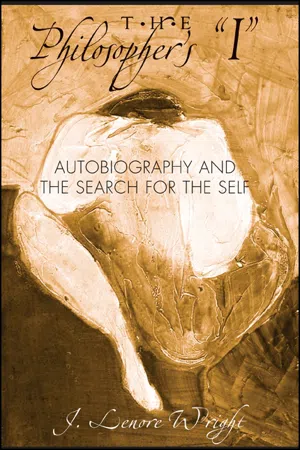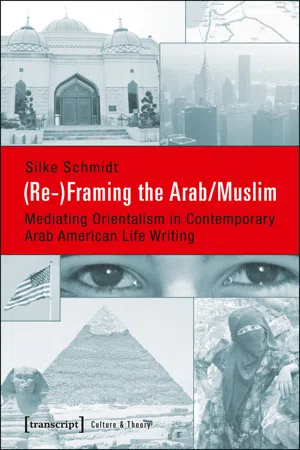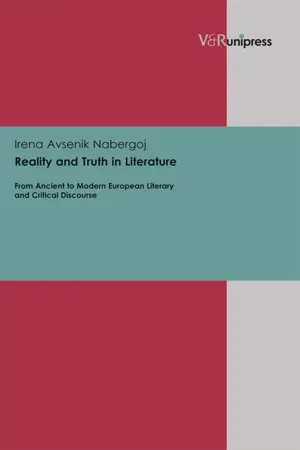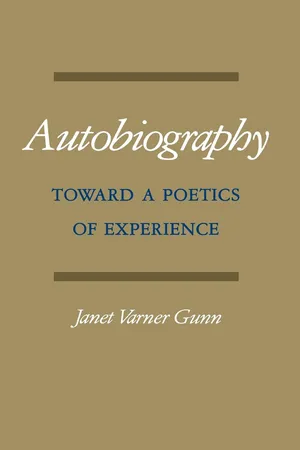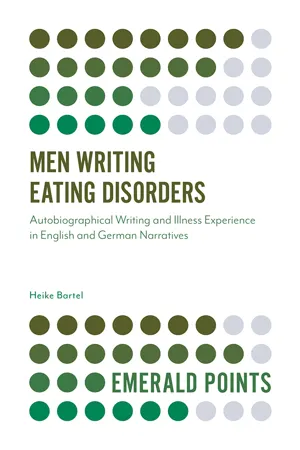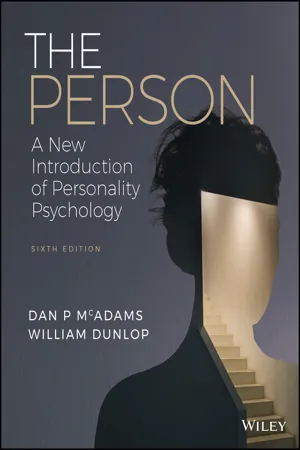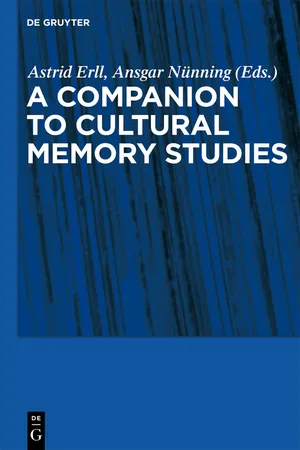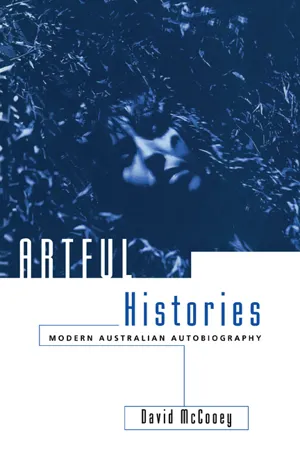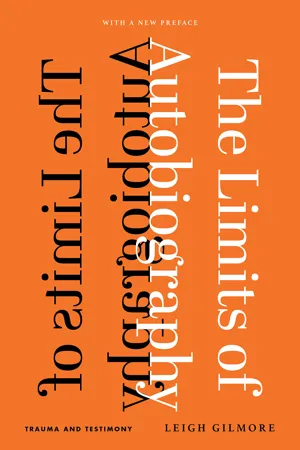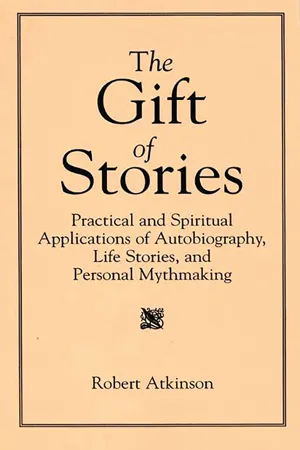Literature
Autobiography
An autobiography is a written account of a person's life, written by that person. It provides a first-person perspective on the author's experiences, thoughts, and emotions. Autobiographies are a popular literary genre that allows readers to gain insight into the life and perspective of the author.
Written by Perlego with AI-assistance
Related key terms
1 of 5
12 Key excerpts on "Autobiography"
- eBook - PDF
The Philosopher's "I"
Autobiography and the Search for the Self
- J. Lenore Wright(Author)
- 2012(Publication Date)
- SUNY Press(Publisher)
Autobiography is a special mode of first-person writing that merges these sets of conditions into one expressive literary form, allowing the autobi- ography to be both a genre of literature and an interpretation of experience. For although we do not and cannot confront ourselves as others do, we do, as Georg Misch maintains, possess ourselves as beings conscious of ourselves and capable of uttering ‘I.’ 28 We sometimes choose to shed some of the masks that we wear and treat ourselves as an other, a person independent of the being we confront every day. In these instances, the ‘I’ becomes a ‘you,’ revealing the I-you characteristic of the self-in-the-world (the linguistic self ). 29 To be sure, literary conventions liberate and constrain first-person philo- sophical writing. On the one hand, they offer the philosophical writer methods for self-representation ordinarily unavailable to philosophers. 30 On the other, they muddle the view of the self so clearly expressed in philosophical terms, adding ambiguity to texts in which many writers aim for clarity. Accordingly, Misch argues that Autobiography and its fluid boundaries “can be defined only by summarizing what the term ‘Autobiography’ implies: the description (graphia) of an individual human life (bios) by the individual himself (auto).” 31 By exten- sion, autobiographical writing imposes no particular style or form upon the writer. It simply conveys the fact that the life circumscribed by the writing is the writer’s life in his or her own words. 32 Yet the rhetorical space in which the ‘I’ appears reshapes our traditional notion of subjectivity. 33 First, by acknowledging one’s audience and adopting a rhetorical stance toward that audience, autobiographers give rise to a rhetori- cal subject. 34 Initially the author’s existence is dependent upon the writer’s ex- istence (conversely, the writer’s existence is not dependent upon the author’s existence). - eBook - PDF
(Re-)Framing the Arab/Muslim
Mediating Orientalism in Contemporary Arab American Life Writing
- Silke Schmidt(Author)
- 2014(Publication Date)
- transcript Verlag(Publisher)
It demonstrates that the writing about life writing is not an easy row to how, either. The problem already starts with defining the subject matter. Autobiography very basically defined is “the story of one’s life written by him-self” (Spender qtd. in Smith and Watson, Reading Autobiography 2). The Greek term literally means “self life writing” (Smith and Watson, Reading Autobiography 1). 1 The French theorist Philippe Lejeune in the 1980s added a more expansive definition by declaring that Autobiography is a “retrospective narrative in prose that someone makes of his own existence [...]” (qtd. in Smith and Watson, Reading Autobiography 2). What combines most definitions formulated by Autobiography researchers in recent periods is that the term serves as a genre description used for written autobiographical accounts in contradistinction to fictional genres, such as novels (de Man 919). Autobiographical writing is a century-old phenomenon reaching back to the ear-ly records of Christianity, the diaries of famous leaders in China, and the memoirs of European philosophers. Ancient rulers and public figures wrote down their lives in order to share their insights and leave a legacy to their successors with their accounts serving as historical documents (Smith and Watson, Reading Auto-biography 10). The most famous and often-cited examples include St. Augustine’s Confessions 2 written in 397 AD and Jean Jacques Rousseau’s autobiographical 1 The term is derived from the literal translation of “autos” in Greek meaning “self,” “bios” as “life” and “graphe” for “writing” (Smith and Watson, Reading Autobiography 1). 2 The prominence of the title ‘confessions’ already reveals the testimonial nature of auto-biography. Personal insights here are inherently related to the act of revealing one’s in- L IFE W RITING T HEORY | 49 records published in 1782 under the same title (de Man 172). - eBook - PDF
Reality and Truth in Literature
From Ancient to Modern European Literary and Critical Discourse
- Irena Avsenik Nabergoj(Author)
- 2013(Publication Date)
- V&R Unipress(Publisher)
Thus, the tension between the presentation of objective reality and subjective creativity in auto- biography is more explicit than in traditional forms of literature. This chapter deals primarily with the characteristics of autobiographical writing and examines the problem of truth in certain classic biographical and autobiographical works from antiquity to the present. The presentation of various stances in literary criticism regarding the role of biographical and au- tobiographical writing, and regarding the originality of individual authors’ manners of presenting reality and past events, sheds light on the criteria for judging authenticity or truth in literature. The very nature of autobiographical writing indicates why the question of reality and truth in these literary types appears as a central question to which authors, each in his or her own manner, respond both directly and indirectly. 4.1 Autobiographical Literature as a Sub-Section of Biographical Literature, and the Problem of Reality Rather than establishing rules for autobiographical narratives as a genre or form, the definition of autobiographical narrative understands such telling as an historically-inserted instance of self-presentation. In Autobiography the nar- rators selectively present their life story through a personal narrative. Inserted into specific times and places, Autobiography is simultaneously in dialogue with individual processes and archives of memory. Because the history of such self- referential literary models is so rich and varied, Sidonie Smith and Julia Watson differentiate among three types: life writing, life narrative, and Autobiography. Life writing is a general term for writing that focuses on an individual life as a subject: “Such writing can be biographical, novelistic, historical, or explicitly self-referential and therefore autobiographical. - eBook - PDF
Autobiography
Toward a Poetics of Experience
- Janet Varner Gunn(Author)
- 2017(Publication Date)
- University of Pennsylvania Press(Publisher)
28 28. See Stanley Fish, Literature in the Reader: Affective Stylis-tics, New Literary History II (1970): 123-62; Norman Holland, The Dy-namics of Literary Response (New York: Oxford University Press, 1968); iS Autobiography: TOWARD A POETICS OF EXPERIENCE All too often, this newly discovered dimension of tex-tual experience—or the rediscovery of what surely goes back as far as Longinus—has led to the psychologizing of literature or to the professionalization of reading. In the case of the former, the text becomes a behavioristic model to which response can be quantified, measured, and even pre-dicted. In the case of the latter, the reader must don special attire either to plunge for deep structures or to catapult out of time in order to reconstruct authorial intention or to anatomize originating genres. But the autobiographical response, like the autobio-graphical self, cannot be quarantined to some sterile corner outside of culture. It belongs instead to the larger cultural context where reading is simply part of a capacity to func-tion adequately as a human being. In modern western cul-ture (the culture out of which Autobiography emerged), literacy is indispensable to fully human survival. Reading takes place, then, in a cultural context—a con-text whose symbols and whose u webs of significance are both products of and models for such interpretive activity as reading represents. It is out of this context, and by virtue of it, that readers respond. As I hope to show in a later chapter, that response combines two modes of interpretive activity. On the one hand, the reader experiences the autobi-ographical text as an occasion of discovery: of seeing in the text the heretofore unexpressed or unrecognized depth of the reader's self—not as a mirror image, nor even as a partic-ular manifestation of some shared idea of selfhood, but as an instance of interpretive activity that risks display. - eBook - ePub
Men Writing Eating Disorders
Autobiographical Writing and Illness Experience in English and German Narratives
- Heike Bartel(Author)
- 2020(Publication Date)
- Emerald Publishing Limited(Publisher)
The genre of Autobiography has a long literary tradition since the eighteenth century that, historically, has authoritatively demarcated the field of writing one’s own life. In the English-speaking context, the term ‘memoir’ has in recent years replaced the term ‘Autobiography’ in common usage despite generic differences. ‘Memoir’ still has very different connotations in the German context 1 and will therefore not be a major term of reference for literary scholarship in this study. Recent work in English and German Studies has contested and re-drawn the traditional boundaries of Autobiography. 2 Scholars in the field highlight that when it comes to writing the self, research needs to move beyond the concept of a fixed literary genre of Autobiography and work with ‘a moving target and an ever-changing practice without absolute rules’ (Smith & Watson, 2010, p. 8). It is within this ‘moving’ context of writing within, but also in defiance of, a particular literary tradition that we establish the narrative framework for our texts as a new contribution to a constantly evolving field of research. Undoubtedly, the notion of writing about one’s own life is at the centre of both terms, ‘Autobiography’ and ‘autobiographical writing’. However, this study prefers the adjective ‘autobiographical’ to describe processes and outcomes of writing; in this it follows most recent scholarship in the field (e.g. Wagner-Egelhaaf, 2019). This marks a shift away from the historical concept of the Autobiography as a long-established genre, and from a canon that historically only included particular types of ‘master narrative’ of ‘the sovereign self’ (Smith & Watson, 2010, p. 3). Anne Fleig emphasises: ‘It is not by accident that the so-called “golden age of European Autobiography” around 1800 coincides with the establishment of male concepts of authorship - eBook - PDF
The Person
A New Introduction to Personality Psychology
- Dan P. McAdams, William L. Dunlop(Authors)
- 2022(Publication Date)
- Wiley(Publisher)
357 PART IV The Person as Autobiographical Author Stories teach us how to be human. From Tolstoy to Hollywood, the great novelists and filmmakers plumb the depths of human minds and explore the countless ways people relate to other people and to themselves, how we love each other and how we hate, how we move through life and how we build a life from one moment to the next. As they thrill and inspire us, or bring us to tears, stories track human consciousness and behav- ior developing over time. As such, we cannot help but tell stories about our own lives, too, little stories at first, but eventually larger narratives about who we are and how we came to be the people we are becoming. More even than our traits and goals, our stories express how each of us is a unique person, and how we are, at the same time, intricately tied to others and to the specific world in which our story is told. Chapter 12 Life Stories Chapter 13 Narrative, Culture, and the Adult Life Course Chapter 14 Psychological Biography and the Narrative Study of Lives 358 12 Life Stories About 300 years ago, a peculiar new form of literary expression emerged in Western Europe. It was called the novel. In early examples like Daniel Defoe’s Robinson Crusoe, novelists created extended prose narratives that imaginatively depicted the experience of being human – feelings, thoughts, desires, and behaviors – through a sequence of events involving a particular group of persons living in a particular time and place. The power of the novel lay in its ability to explore subjective human experience with extraordinary breadth, depth, and authenticity. By tracking over time how people perform as social actors and what they want and value as motivated agents, the novel expresses how characters change, as well as how they remain the same, over the course of seconds, minutes, days, years, and even decades. - eBook - PDF
A Companion to Cultural Memory Studies
An International and Interdisciplinary Handbook
- Astrid Erll, Ansgar Nünning(Authors)
- 2008(Publication Date)
- De Gruyter(Publisher)
Life-Writing, Cultural Memory, and Literary Studies M AX S AUNDERS “Life-writing” is a contentious term. It covers a wide range of texts and forms. Indeed, its contentiousness arises at least partly because it seems, to some, to cover too many. As one leading British biographer, Hermione Lee, writes, it is sometimes used “when different ways of telling a life-story—memoir, Autobiography, biography, diary, letters, autobiographical fiction—are being discussed together” (100). This is the main sense in which I shall be using it. Though, as Lee notes, another main usage is “when the distinction between biography and Autobiography is being de-liberately blurred” (100). Critics sometimes use the term “auto/biography” to indicate this generic fusion (or, again, as a shorthand for talking of the genres Autobiography and biography together). The term “Autobiography” was coined as Romanticism took shape towards the end of the eighteenth century. Paradoxically, this is also the period in which the view began to emerge that all writing had an autobiographical dimension. According to this view, which became increasingly consolidated through the nineteenth century, and which is even shared by Postmodernism, the distinction be-tween Autobiography and other forms such as biography or fiction is thus always already blurred. The two senses distinguished by Lee are then not as distinct as they might have seemed. A memoir of someone else, by virtue of the fact that you are writing about them because they were im-portant in your life, will be part of your Autobiography. That scholars are prepared to spend years of their lives immersing themselves in the biogra-phies of others tells you something about their biographies. To some ex-tent they are writing displaced autobiographies; and that vector of dis-placement is what lends even the most scrupulously factual biography its admixture of fictionality. - eBook - PDF
Artful Histories
Modern Australian Autobiography
- David McCooey(Author)
- 1996(Publication Date)
- Cambridge University Press(Publisher)
C H A P T E R Autobiography and History Interpretation would be impossible if expressions of life were completely strange. It would be unnecessary if nothing strange were in them. It lies, therefore, between these two extremes. 1 THEORIES OF Autobiography Defining Autobiography is notoriously difficult. To consider Autobiography as a historical discourse and distinct from fiction is currently (perhaps sur- prisingly to some) an unfashionable position. It is not, however, one which should be dismissed out of hand; not only because such a position may give insights into the condition of Autobiography, but also because issues of historicity, reference and individuality relate directly to people's everyday experiences. The difficulty in defining Autobiography has arisen from the sense of relativism and indeterminacy commonly associated with post-structuralist literary theories. In failing to find a formal definition of the genre, many theorists of Autobiography simply refuse any generic difference between Autobiography and fiction. Numerous critics in recent years have argued for the fictional status of Autobiography. For instance, Robert Elbaz states that 'through the process of mediation (by linguistic reality) and suspension (due to the text's lack of finality and completion), Autobiography can only be a fiction', 2 and Susanna Egan believes that fiction 'ensnares reality from the beginning' of the autobiographical act. 3 Some commentators make up for this apparent fictionality of Autobiography by claiming that a 'higher truth' can be rendered which goes beyond mere historical detail. Such a view is implicit in James Olney's consideration of Eliot's Four Quartets as Autobiography as it deals with personal truths. 4 In this model, the biographical status (the bios) of A R T F U L H I S T O R I E S the autobiographical subject is irrelevant. - eBook - PDF
Handbook of Narrative Inquiry
Mapping a Methodology
- D. Jean Clandinin(Author)
- 2006(Publication Date)
- SAGE Publications, Inc(Publisher)
. . . Autobiography [therefore] presupposes a writer intent upon reflection on this inward realm of experience, someone for whom this inner world of experience is important. (pp. 822–823) From this perspective, we can perhaps understand more clearly Goethe’s insistence on linking up “truth” and “poetry”: The inner world is a world like no other, and coming to terms with it, through autobiographical reflection and writing, cannot be the sort of more dispassionate process one sometimes has recourse to in encountering the external world. As an important aside, it should be emphasized that this issue presents quite remarkable challenges for narrative inquiry. What the narrative researcher often deals with, in essence, are auto biographical (i.e., first-person) data that he or she must render in bio graphical (i.e., third-person) terms. Even if he or she aspires toward achieving some measure of objectivity vis-à-vis these data, there neverthe-less remains the stubborn fact that these same data will be shot through with 128 —— STARTING WITH TELLING STORIES subjectivity, interpretation, and imagination. Put in the simplest of terms, in auto-biographical understanding there is no object, no “text,” outside the self; even though the autobiographer may draw on certain personal documents and the like during the course of fashioning his or her story, the phenomenon that is ultimately of concern—namely one’s personal past—must itself be fashioned through poiesis , that is, through the interpretive and imaginative labor of meaning making (Freeman, 1999a, 1999b). The autobiographer thus interprets what he or she has already constructed through imagination, after which time the narrative researcher must try somehow to turn these rather unwieldy data into the kind of account that others might read and, perhaps, learn from. - eBook - ePub
The Limits of Autobiography
Trauma and Testimony
- Leigh Gilmore(Author)
- 2023(Publication Date)
- Cornell University Press(Publisher)
8 These contexts are reproducible; repetition of the forms that characterize them establish expectations in audiences. Yet conventions about truth telling, salutary as they are, can be inimical to the ways in which some writers bring trauma stories into language. The portals are too narrow and the demands too restrictive. Moreover, the judgments they invite may be too similar to forms in which trauma was experienced. When the contest is over who can tell the truth, the risk of being accused of lying (or malingering, or inflating, or whining) threatens the writer into continued silence. In this scenario, the autobiographical project may swerve from the form of Autobiography even as it embraces the project of self-representation. These departures offer an opportunity to calibrate our attention to the range of demands made by Autobiography and the silencing or shaming effects they impose.The recent example of 1992 Nobel Peace Prize winner, activist for the rights of the Quiché people in Guatemala, and author Rigoberta Menchú is instructive here. At the end of 1998, the New York Times broke the story that Menchú’s celebrated Autobiography was filled with inaccuracies and downright misrepresentations. In his book Rigoberta Menchú and the Story of All Poor Guatemalans, American anthropologist David Stoll concluded after a decade of research that I, Rigoberta Menchú: An Indian Woman in Guatemala “cannot be the eyewitness account it purports to be” because Menchú describes as her own “experiences she never had herself.”9 - eBook - PDF
- Scott C. Flanagan, Shinsaku Kohei, Ichiro Miyake(Authors)
- 1987(Publication Date)
- Yale University Press(Publisher)
Certain groups within the population are dispropor-tionately represented. Authors usually represent the wealthier and more educated levels of society, although a careful search in specialized bibli-ographies will uncover a number of books written by working-class au-thors or authors with little formal education. Still, the very act of writing a book implies a certain familiarity with the literary world, so the au-thor's reading habits may not be typical of other individuals of his or her social and educational background. In spite of these limitations, one can learn about a reasonably wide cross-section of the population of readers through autobiographies. 2 The special virtue of autobiographies in the history of reading is that they allow us to move our focus from the content of reading materials to 1. All of our autobiographers in this chapter are white; Carl Kaestle expects to explore literacy's role for black autobiographers in future essays. On the special mean-ing of Autobiography for women writers, see Susan Stanford Friedman, Women's Autobiographical Selves: Theory and Practice, in The Private Self: Theory and Prac-tice of Women's Autobiographical Writings, ed. Shari Benstock (Chapel Hill: University of North Carolina Press, 1988), 34-62. 2. Two excellent general bibliographies of American Autobiography exist, as wel as numerous specialized guides that provide the researcher ready access to literally thousands of published autobiographies. Louis Kaplan, A Bibliography of American Autobiography (Madison: University of Wisconsin Press, 1961); Mary Louise Bris-coe, American Autobiography, 1945-1980: A Bibliography (Madison: University of Wisconsin Press, 1982); Patricia K. Addis, Through a Woman's I: An Annotated Bibli-ography of American Women's Autobiographical Writings, 1946-1976 (Metuchen, N.J.: Scarecrow Press, 1983); Russell C. - eBook - PDF
The Gift of Stories
Practical and Spiritual Applications of Autobiography, Life Stories, and Personal Mythmaking
- Robert Atkinson(Author)
- 1995(Publication Date)
- Praeger(Publisher)
There are many ways we can tell our story to get at the meaning in our lives, to integrate the pieces of our lives, and to connect our experience to that of others. It is important for us to find our own style, our own particular way of expressing our story that feels right and natural to us. St. Augustine used the confessional. Dante used allegory. Thoreau wrote about himself in the context of nature. Today many seem comfortable presenting their memories, their story, as autobiographical fiction, impressionistically pre- senting the self in the way they want others to know them. Yet, this is what we have always done. We can only present what we want of ourselves in the way we want to. Most life storytelling is a combination of all of these ways, thereby blurring the boundaries between autobiogra- phy, memoir, journal writing, and other forms of writing about the self. Sometimes there can even be a blur between a serious and a lighthearted approach to life storytelling. The lighthearted can turn out to have its serious side and the serious its irony, if not lightness. Wisdom, insight, and depth can be clothed in any garment. The similarity in intent between two very different styles can be quite striking. Take for example the writing of Etty Hillesum, a Jewish woman in her late twenties who died at Auschwitz. Her diaries of 1941-43 present a self deeply sensitive to everything that touches her life. Paradoxically, the total destruction that was going on all around her was not her focus. She put all 54 The Gift of Stories of her writing within the context of her expanding spiritual awareness, which led her to the source of her existence: Life is composed of tales waiting to be retold by me. Oh, what nonsense— I don't really know anything A hard life is in store for me.
Index pages curate the most relevant extracts from our library of academic textbooks. They’ve been created using an in-house natural language model (NLM), each adding context and meaning to key research topics.
